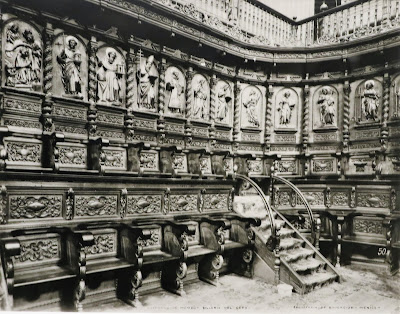The photography at the Mexican Modernism Exhibition at the Denver Art Museum is spectacular. My personal favorite is the portrait below of Frida Kahlo taken by Edward Weston. Note, by clicking on any of the images, you will be able to view it full screen.
Weston and his Hollywood actress and political
activist, Tina Modotti, lived in Mexico City from
1923 to 1927 where they opened a portrait studio. This is where they met Diego Rivera. It was when Weston was living in Carmel, he headed north to San Francisco to see Diego and meet his new wife. He was intrigued and mesmerized by Frida. Above Frida is wearing an indigenous dress, a European silk shawl, three strands of Aztec jade beads and intricate dangling earrings
Weston's style shifted to a more direct, sharply focused and structured photographic style known as “straight” photography, which was championed by Alfred Stieglitz. He was well known for shooting images of nature, close-ups of vegetables and people’s faces.
Large Ladder - Manuel Alvarez Bravo - 1932
Bravo was born in Mexico City in 1902. He was a photographer most famous for his poetic images of Mexican people and places.
He was heavily involved with the surge of artistic renaissance that occurred after the Mexican Revolution. He was also influenced by international influences, notably Surrealism, thou his art was truly centered around the Mexican culture.
Born into an artistic family, it was after meeting German photographer Hugo Brehme in 1923, that he purchased his first camera.
He was largely self-taught. Thru his friendship with Tina Modotti, he met Edward Weston and many of the leading artists of the Mexican Renaissance; Diego Rivera, Frida Kahlo, Rufino Tamayo, David Alfaro Siquueiros and Jose Clement Orozco.
He took over Modotti’s job as photographer for the magazine Mexican Folkways after her deportation. He had his first one-man show in 1932. He also worked at a cameraman on Sergey Eisenstein's film Que Viva Mexico that was never completed.
Organ Pipe Cacti - Manuel Alvarez Bravo - 1929 - 1930
It was his still photography that gained him fame. Influenced by Weston, his close up photographs took on an artistic abstract nature. Later on he was more interested in the urban landscape of Mexico City , a documentary of Mexican life, the villages and its people.
Person standing behind a fabricated box, holding a dark cloth over his head.
Ruth was the first woman student of the College of Engineering and Architecture at the National Polytechnic Institute and her career centered on teaching the theory and practice related to architecture.
Wilhelm (Guillermo) Kahlo (Frida's father) was born in Germany in 1871 and later moved to Mexico City in 1891 where he had his own photography studio, specializing in buildings, room interiors, factories and machinery. Upon his arrival he changed his name from Wilhelm to Guillermo. Following some commercial success, he was commissioned under the regime of Porfirio Díaz, President of Mexico in the early 1900s, to document the country's colonial architecture, government buildings, infrastructure, landmarks, monuments, streets and churches.
Mexico City's Cathedral - Choir Stalls - Guillermo Kahlo - 1920's
Photography played a huge role in documenting the political events during the Mexican Revolution (1910 – 20).
In the 1920's Guillermo's church photographs were republished in six volumes titled Iglesias de Mexico / Churches of Mexico. His photography was no longer seen simply as monuments to European religious tradition, the churches he captured were reinterpreted for their vernacular qualities and the role of the indigenous workers who built them.
Fritz Henle (June 9, 1909 – January 31, 1993) was a German-born
photographer, known as "Mr. Rollei" for his use of the 2.25" square
format film used in the Rolleiflex camera. It was Frida who invited Henle to her home, Casa Azul in Coyoacon, several times to photograph her.
He photographed fashion, portrait, travel and industrial subjects and his work was published by Life, Mademoiselle, Town & Country and Harper's Bazaar magazines.
Imogeen Cunningham was born in 1883. She was an American photographer who was best known for her portraits and her images of plant life.
In 1930, Frida and Diego moved to San Francisco where Diego was working on two separate murals. That is where Kahlo met Cunningham. Cunningham captured the essence of Frida with her calm, pensive gaze into the camera dressed with the traditional Mexican shawl (reboza), her jewelry and hairstyle.
Also, she “ … effectively manipulated her self-image before the lens through her gaze, pose, and the carefully constructed symbolism of her clothing, jewelry, and hairstyles.”
DENVER ART MUSEUM
























